Warriors, is there a connection between the Aspire assessment (College Board) and the recently introduced “ASPIRE Act” (Senate)? Is Congress a puppet for the CCSS Machine? Could it be Congress is mimicking the CCSS Machine?
What am I talking about?! The “ASPIRE Act” in Congress is supposedly a solution to a massive education problems concerning higher education. However the “Aspire” Assessment by the College Board is ALSO being used as a massive ‘solution’ for higher education.
The remainder of this article will take an in-depth look.
Before the ASPIRE Act, there was College Board’s ‘Aspire’:
Basically, Aspire is just like the other assessments meant to pigeon hole your student’s education. So, from middle school through college or trade school, Aspire dictates their path.(What if your student isn’t in a school where Aspire is given? Depending on which State you live in, the skill based assessments WILL be given to them.)
I wrote about this back in 2016, see:
https://www.commoncorediva.com/2016/07/11/assessment-quest-parts-1-and-2/
Before “Aspire”, I revealed another College Board assessment which is a ‘cousin’ to the other types of skill based assessments, called “Springboard”. You can learn all about it from my 2014 article, https://www.commoncorediva.com/2014/10/18/sic-em-saturday-springboarding-into-the-ccssap-pool/
From the College Board’s “How We’re Governed” page, “More than 6,000 two- and four-year colleges, universities, secondary schools and districts, higher education systems, and other nonprofit organizations compose the College Board.”
To see the entire page: https://www.collegeboard.org/about/governance
In the ESSA (Every Student Succeeds Act) Era, what impact is College Board having on our States? Look at where I live (NC). What was laid out in 2011, continues today.
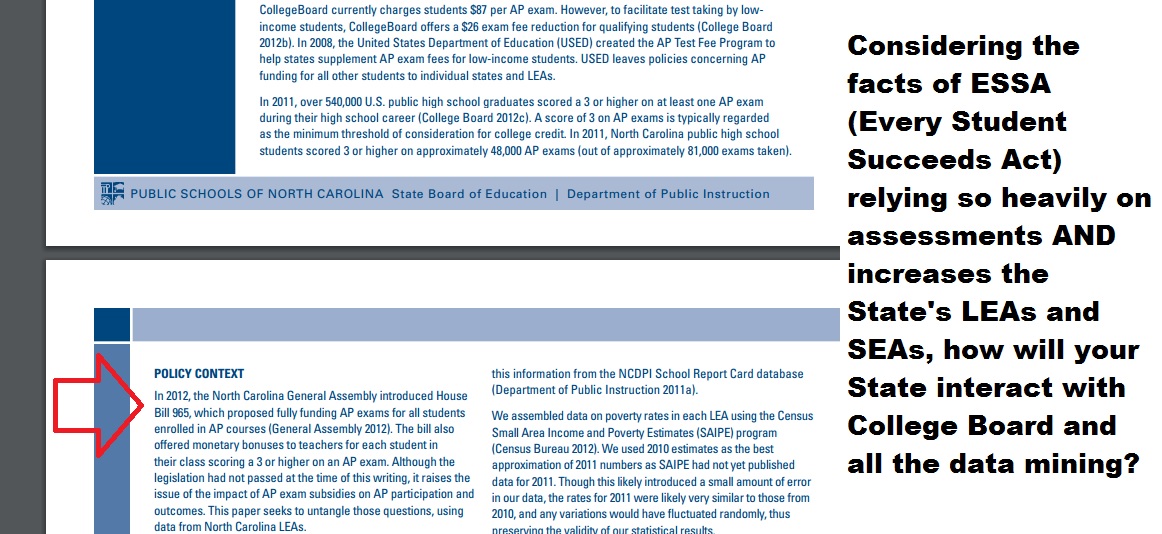
SAT and ACT appear to be ESSA’s national assessments, so what about our States already subsidizing these assessments? What will the per State federal funding formulas for ‘nationally normed assessments’ look like?
According to the Education Commission of the States (www.ecs.org), where I live (NC) MUST have a partnership with a group such as The College Board! Why? To ensure college readiness for those in high school. To see all the parameters (including teachers, subsidies, and more): http://ecs.force.com/mbdata/mbstprofexcL?Rep=APP16&st=North%20Carolina
According to the ECS’ NC specific page, since 2013, there’s been a State Statue for providing alternate College Board assessments! Click to enlarge the screen shot below. If you cannot, the grade range for these alternates? P-12th! (see below)
But, what if you don’t live in NC? http://www.ecs.org/state-legislation-by-state/
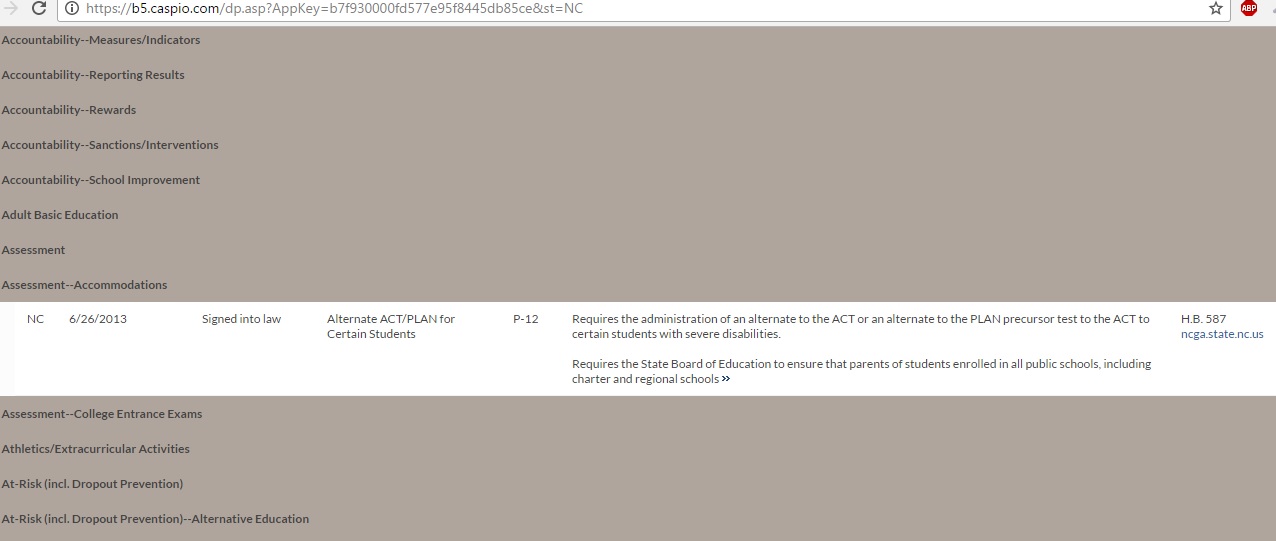
ECS is absolutely on the CCSS Machine side of education. Look at the leadership, check out their state-by-state leaders (find these under the “Commissioners By State” tab when visiting the link below), and their partners. The Gates Foundation, USA Funds, Walton Family Foundation, GE Foundation, ACT, Pearson, Scholastic, AT & T, State Farm, AdvancED, Avid, Bloomboard, ETS, Questar, College Board, KnowledgeWorks, Measured Progress, Meta Metrics, Microsoft, SAS, Reainassance Learning, and the National Assoc. of Charter School Authorizers.
See it all: http://www.ecs.org/about-us/partners/
The Senate’s “ASPIRE Act”:
1) Two U.S. Senators are pushing this ‘post secondary success bill’, Sen. Isakson (GA) and Sen. Coons (DE).
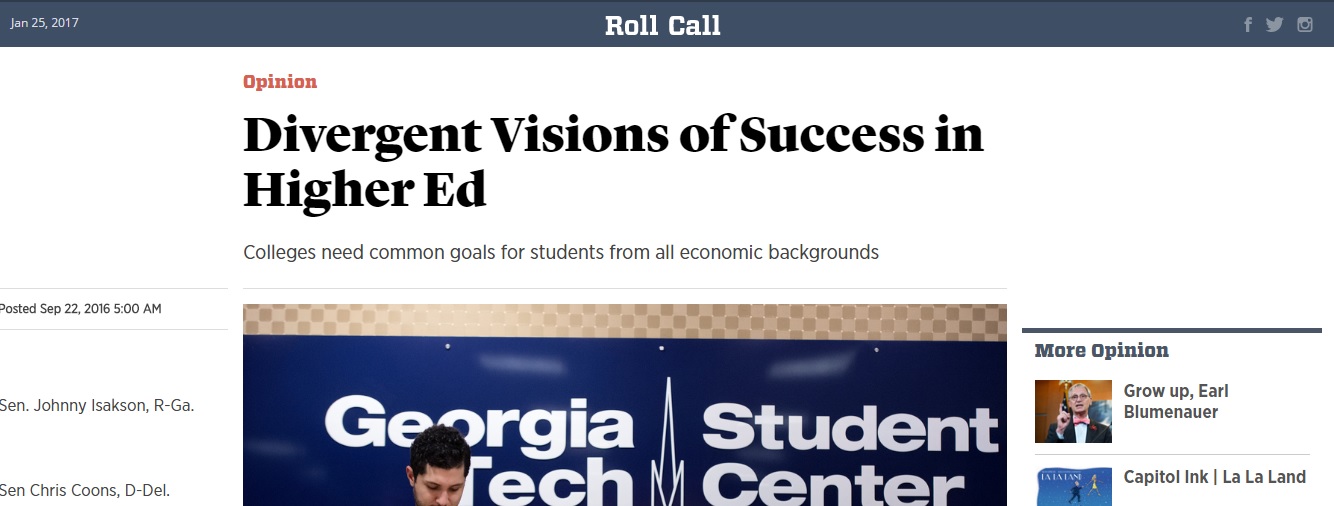
2) The goals of the “ASPIRE Act” appear to be (a) reduce student debt; and (b) reducing drop-outs. Here’s an excerpt, “That’s why we teamed up to tackle both ends of the college access and college completion problem so that colleges start meeting students’ definition of success.” You can read the entire article, http://www.rollcall.com/news/politics/colleges-universities-debt-success
The resource both Senators cite in their joint effort to help American students? Data from the College Board!
3) So, what does the acronym “ASPIRE” stand for? “Access, Success, and Persistence in Reshaping Education Act of 2016”. The “ASPIRE Act”( S3368) link:
https://www.congress.gov/bill/114th-congress/senate-bill/3368/text
4) According to the legislative summary, of the ASPIRE Act, by the National Association of Student Personnel Administrators (NASPA), the U.S. Secretary of Education would ‘create two thresholds’ to determine which post-secondary institutions and what students would be impacted. See:
https://www.naspa.org/rpi/posts/congress-introduces-the-aspire-act-in-efforts-to-close-the-completion-gap (*Note: the Gates Foundation gave NASPA over $1 million dollars in 2016 and just over $285,000.00 in 2015. See: http://www.gatesfoundation.org/How-We-Work/Quick-Links/Grants-Database#q/k=NASPA )
5) The ASPIRE Act (S3368) has quite a bit of ‘reshaping’ planned:
i) Amends the HEA (Higher Education Act of 1965). HEA was last re-authorized in 2008.
ii) S3368 was introduced to the U.S. Senate in Sept. 2016 and is currently in the HELP Committee.
iii) The definition of ASPIRE: “Improving College Access and Completion for All Students.”
iv) Lots of expenses will be attached to making college access for all, including updating technology..aka: more taxpayer burdens for data mining our students.
v) Secretary of Education is given more power. This makes sense, as ESSA (Every Student Succeeds Act) does the same. (Since the ESSA is to be a part of the WIOA-ESSA-HEA workforce based streamlined education bridge, this has been an expected move we’ve known was coming.)
vi) The lowest performing higher education institutions will face much of the same treatment as those in the K-12th grade system, all at the Secretary’s discretion. (This will impact everyone in the schools. It also leads to what group(s) will take over a consistently failing higher education institution.)
vii) Caught in the midst of all this? Pell Grants.
viii) Each higher educational institution not measuring up to the Secretary’s parameters, will have penalties. Think about this, if a school gets a big penalty fee, who ends up paying for it? More than likely, the taxpayers. (*Note: in this Act, it is clearly stated schools cannot raise tuition or student fees to recapture the cost. You can find this in the “Prohibitions” section which follows all the penalties.)
ix) To get federal school funding, these institutions MUST comply with the ‘improving completion’ program as laid out in this Act. Schools which choose to skip the Secretary’s penalties, will miss out on grants, including ‘bonus’ completion grants.
x) Those higher educational institutions this Act will have impact on are non-profit (all public and most private) and for-profit (proprietary) ones.
xi) The Secretary of Education will create ‘peer groups’ in higher education institutions. The groups are to have 10-15 schools. They must have the following in place.
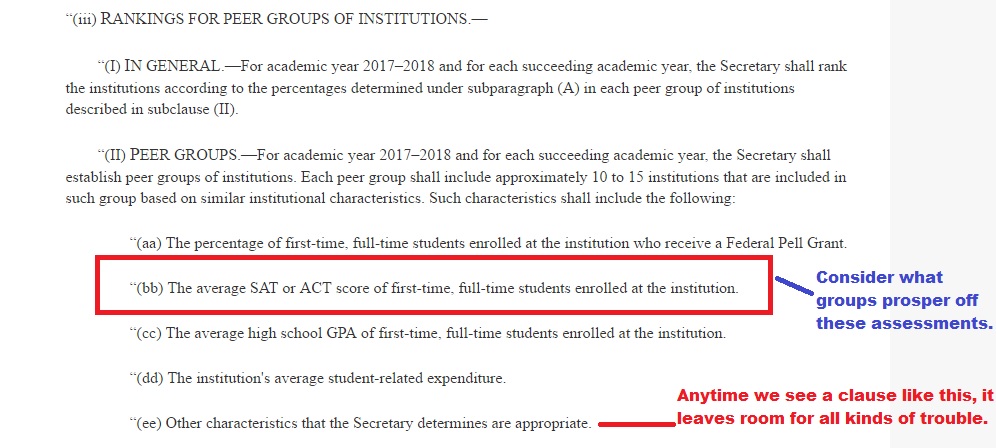
xii) There are a few ‘consumer warnings’ included in this Act. If a higher educational institution is not up to the Secretary’s bar, it must be noted on the school’s website in plain sight. The Secretary will also be issuing a “Consumer Warning Report”. To create this Report, you know lots of data will have to be collected.
xiii) Starting in the 2017-18 school year and every 5th year following it, the Secretary will be able to almost literally pick and choose which schools are in these Peer Groups. (*Note: See Section C under “Calculation of Average”)
xiv) If schools do receive any federal funding, look below for how they are to use those funds.
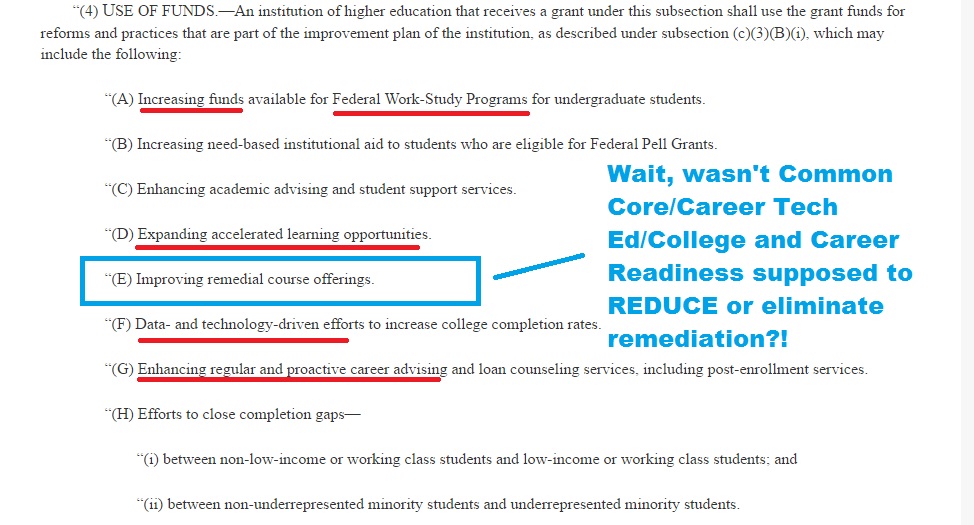 xv) If schools do well with all this Act has, they are eligible for Bonus Grants. Those Bonus Grants must be used in the same way as you see directly above. This Act also includes non-financial ‘rewards’ in the Bonuses. They are “a) Reporting less frequently and avoiding duplicative reporting requirements; b) Extra points in Department grant competitions for which institutions of higher education are eligible entities; c) Waiving the multiple disbursement rule or disbursement delays; and d) Preferable status for experimental sites.”
xv) If schools do well with all this Act has, they are eligible for Bonus Grants. Those Bonus Grants must be used in the same way as you see directly above. This Act also includes non-financial ‘rewards’ in the Bonuses. They are “a) Reporting less frequently and avoiding duplicative reporting requirements; b) Extra points in Department grant competitions for which institutions of higher education are eligible entities; c) Waiving the multiple disbursement rule or disbursement delays; and d) Preferable status for experimental sites.”
xvi) The Secretary will create a data tracking portal. Look for the “best practices” database.
xvii) The Secretary of Education will report to the U.S. Congress within 2 years of this Act’s passage. What will he/she report on? Ways to EXPAND Section 493E of the Higher Education Act of 1965. What’s that Section about? According to the U.S. Dept. of Ed, it’s a section devoted to “Eligibility and Certification” for Higher Education. See: https://www2.ed.gov/policy/highered/leg/hea98/sec493.html (*Note: from what else I found out about Section 493, it was a Section added to the HEA in 1998.)
Puppet or Mimic?
Warriors, this article began with a question. It is clear the ACT and SAT are being used in both the Congress and the CCSS Machine. WHY has Congress become a puppet to the CCSS Machine?! By Congress’s legislation, it forces the States to mimic the CCSS Machine in order to receive federal funds. This, in turn creates a servile society.
********************************************************************
Related Information to Section 493 (Part G of Title 4) of the HEA :
1) The 1998 Federal Registry of all the updates to HEA:
https://ifap.ed.gov/fregisters/attachments/122304.pdf (This is a 4 page document. Page 3 will have certain portions of Section 493.)
1a) To see the U.S. Dept of Ed’s more recent Section 493 (Part G of Title 4) information:
https://www2.ed.gov/policy/highered/leg/hea98/sec493.html
2) From Oregon’s Senator Wyden, this document about Section 493 should be of great concern. Why? It deals with the Integrated Post-secondary Educational Data System (IPEDS). Senator Rubio and Senator Warner helped create this 2013 Act called “Student Right to Know Before You Go Act”. It’s a fancy way of lining students up for workforce based education. To see the Wyden Education Priorities where “Know/Go” is featured:
https://www.wyden.senate.gov/priorities/education To see the nuts and bolts of “Know/Go”, see:
https://www.wyden.senate.gov/download/?id=10D9791A-C6AA-4BDD-9CCB-C57CA8E6BF82&download=1
3) Introduced earlier this month (Jan. 2017), HR 483, “No Funding for Sanctuary Campuses Act”. While this Bill (has been sent to the U.S. House’s Education and Workforce Committee) does not specifically mention Section 493, it does mention Part G of Title 4 of the HEA(1965). The Dept of Homeland Security will have to work with the Dept. of Education on this Bill. To read it for yourselves: https://www.congress.gov/bill/115th-congress/house-bill/483/text/ih?overview=closed&format=xml
Closing:
Warriors, the HEA’s re-authorization will be here soon. It’s the last link in the birth to workforce chain. It streamlines education. The CCSS Machine likes to call it a ‘bridge’. Congress likes to call it a ‘streamlined transition’. We call it ‘criminal’.
A special shout out to all of you who helped make the Anti DeVos/Senate HELP Twitter Blast (this past Thursday) a success. Teamwork rocks!


Sorry but it is too late to stop it. We need to be focusing our time and energy on getting as many kids out from the system as we can. Implode the system from within. It is easy but we need parents to jump on board. I am working with pastors to open one room in their church for a small classroom….ie 5 students. Enroll them i. FREEDOM PROJECT ACADEMY. It is inexpensive, Christian, classical, teacher led, no common core, no data collection, on line school. I meet with my first pastor next week. Then I start rolling with it.